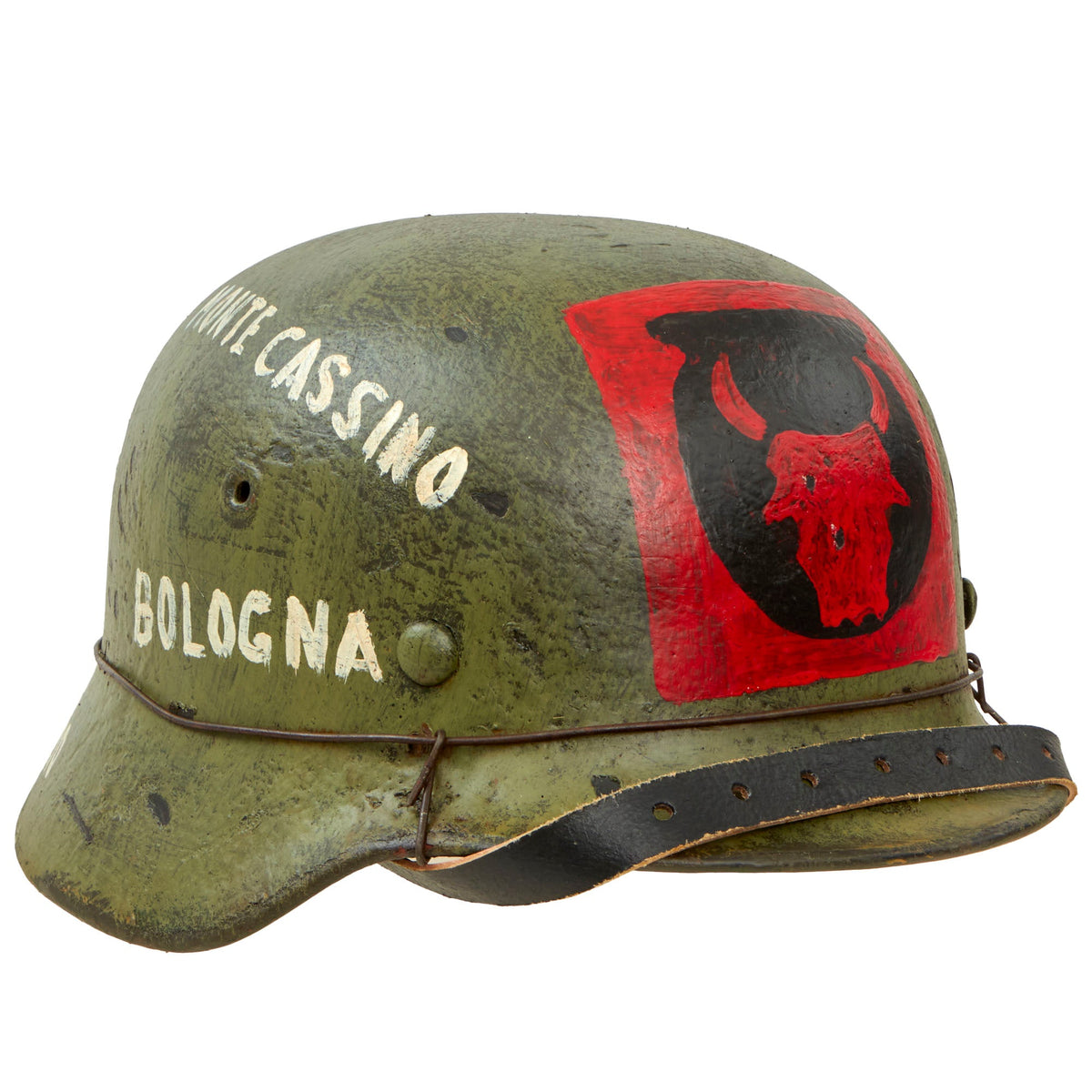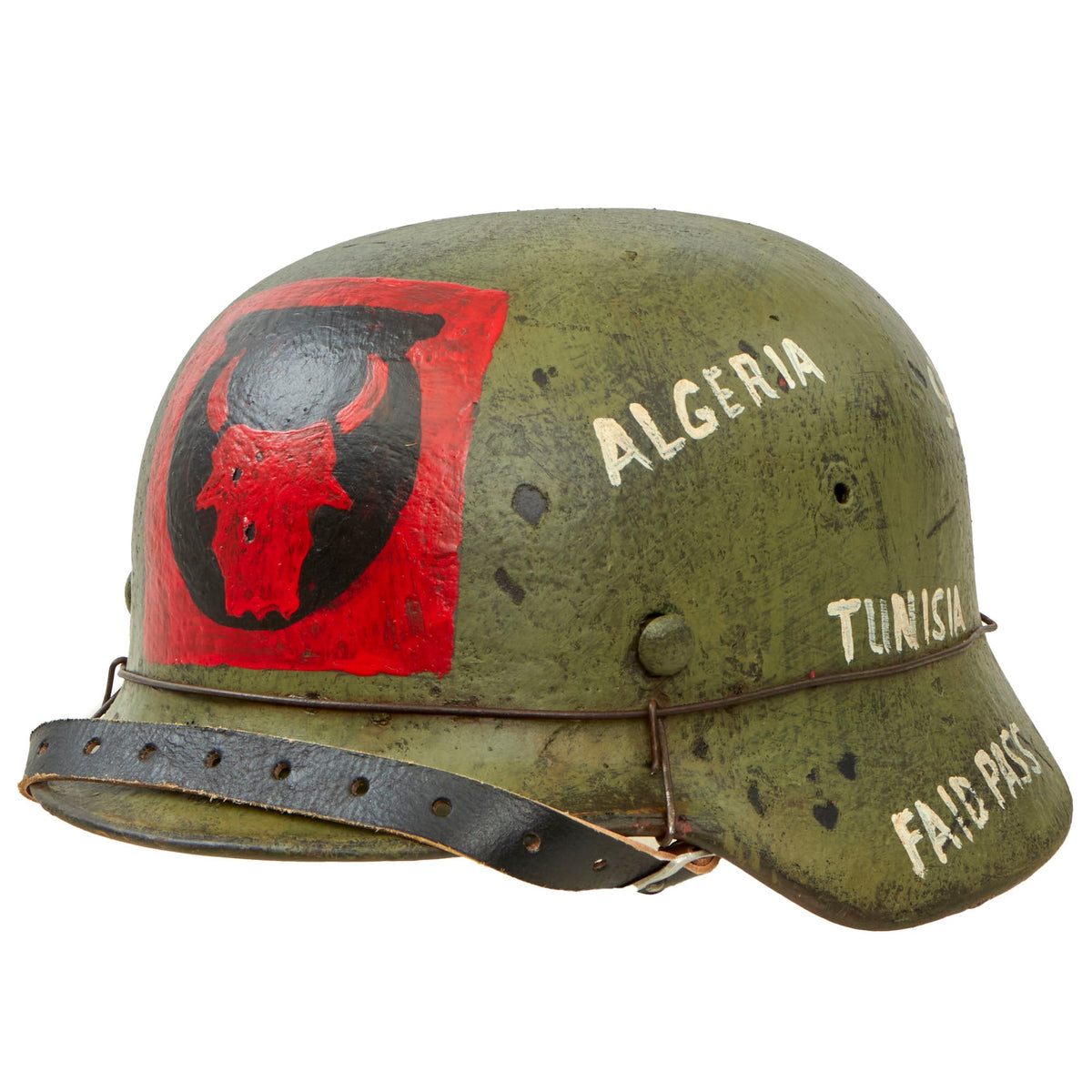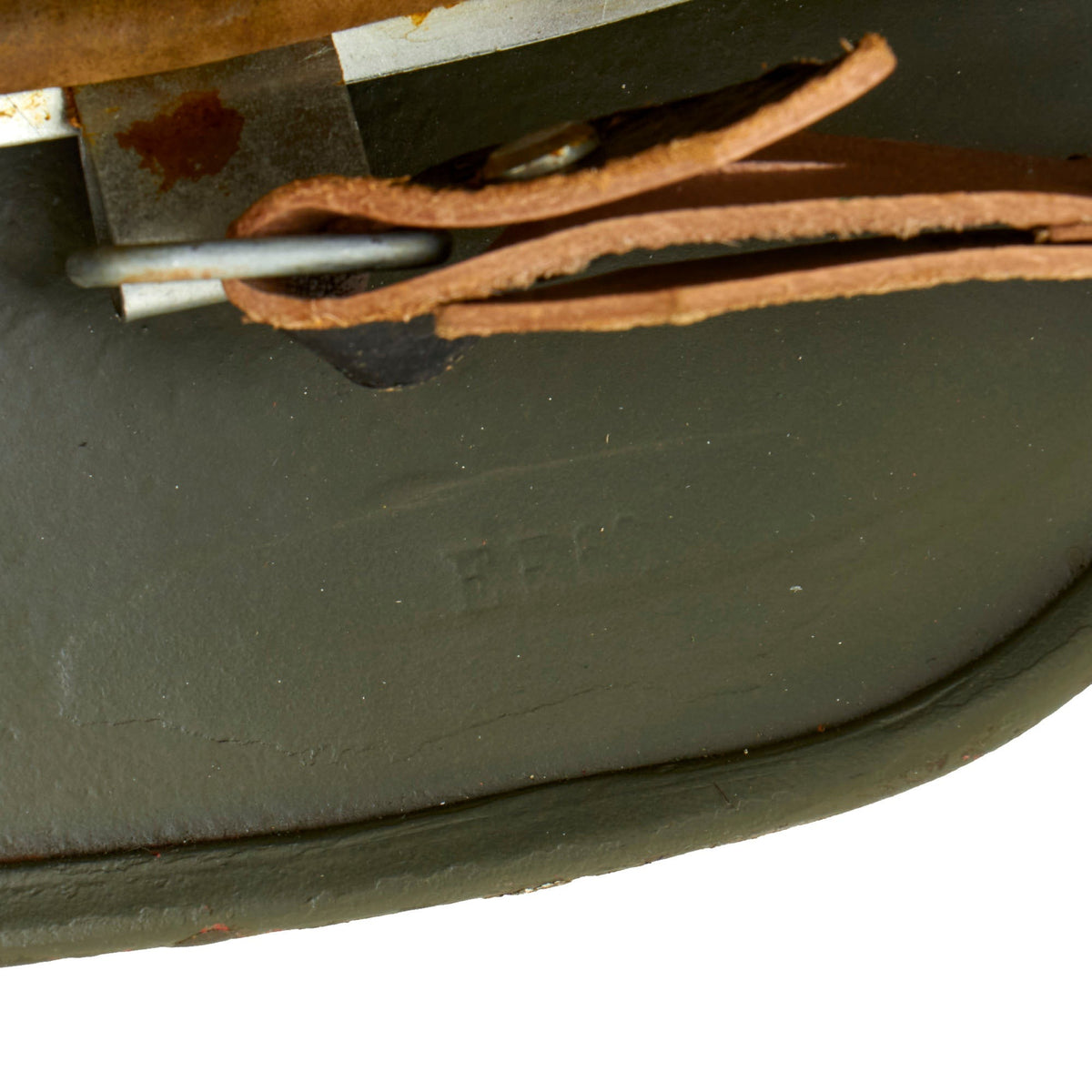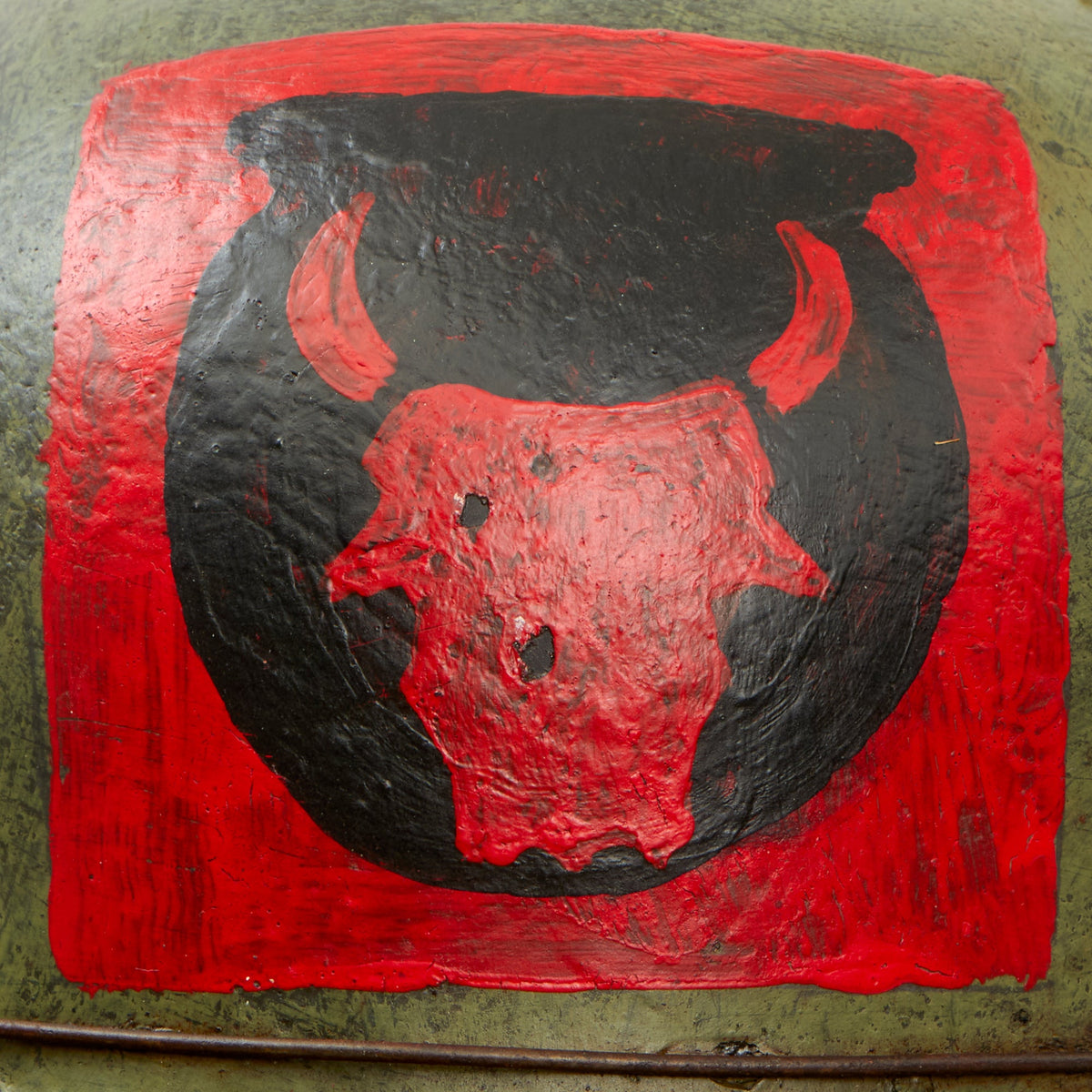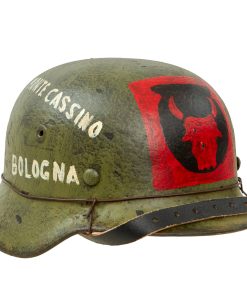Original German WWII M40 Refurbished 34th Infantry “Red Bull” Division Souvenir Camouflage Helmet – Stamped EF66 Original Items
$ 525,00 $ 157,50
Original Item: One-of-a-kind. This is a fine example of totally original Model M40 M-1940 German WW2 large size 66 helmet shell, refurbished by a master German camouflage restorer. The shell is stamped E.F.66, indicating that Emaillierwerke AG, of Fulda, Germany manufactured it. It is also stamped with lot number 5 under the rear skirt. Size 66 is a nice large size that can accommodate liners from 58cm to 59cm or US 7 1/4 to 7 3/8. Size 66 shells are much harder to find and are therefore more valuable to a collector.
Notable history of the WWII M40 Refurbished 34th Infantry Division Souvenir Camouflage Helmet:
– This represents a German Camouflage Helmet captured by Members of the 34th Infantry “Red Bull” Division, decorated on the front with their distinctive unit insignia. It was common for soldiers to personalize “bring back” helmets with their unit insignia.
– The helmet is also marked with ALGERIA, TUNISIA, FAID PASS, ITALY, SOLERNO, GUSTAV LINE, PO VALLEY, ANZIO, MONTE CASSINO, and BOLOGNA, locations visited with the help of the 34th Infantry Airborne Division was in during WWII.
– The 34th Infantry “Red Bull” Division served primarily in the North African and Italian campaigns. They took part in Operation Torch, fighting in Tunisia, and then went to Italy, eventually taking part in Operation Grapeshot during spring 1945 in the Po River valley. They saw 517 days of front line combat during WWII, one of the highest number of combat days of any division in U.S. History. This is second only to the 654 days of the 32nd Infantry Division.
What does refurbished mean? While the shell is 100% genuine WWII manufacture, we have tasked, perhaps the very best German Helmet restorer in the USA, to customize this helmet. Every detail is hand done, with the finest materials including a hand painted shell, with a hand hand aged high quality reproduction liner. Please know that the paint, liner and chinstrap, while they look totally original are all new and the helmet has been refurbished to look as if it was picked up off the battlefield by a USGI and brought home as a war trophy.
This helmet is one-of-a-kind there will never be one exactly like it, making it a true collectors piece that will do nothing but appreciate in value in the coming years. This is a rare opportunity to own a genuine WWII German Helmet for a fraction of the cost of one with original camouflage paint.
34th Infantry Division in WW2:
On 8 January 1942, the 34th Division was transported by train to Fort Dix, New Jersey to quickly prepare for overseas movement. The first contingent embarked at Brooklyn on 14 January 1942 and sailed from New York the next day. The initial group of 4,508 men stepped ashore at 12:15 hrs on 26 January 1942 at Dufferin Quay, Belfast, Northern Ireland. They were met by a delegation including the Governor (Duke of Abercorn), the Prime Minister of Northern Ireland (John Miller Andrews), the Commander of British Troops Northern Ireland (Lieutenant General Sir Harold Franklyn), and the Secretary of State for Air (Sir Archibald Sinclair).
While in Northern Ireland, Hartle was tasked with organizing an American version of the British Commandos, a group of small “hit and run” forces, and promoted his aide-de-camp, Captain William Orlando Darby to lead the new unit.[19] Darby assembled volunteers, and of the first 500 U.S. Army Rangers, 281 came from the 34th Infantry Division. On 20 May 1942, Hartle was designated commanding general of V Corps and Major General Charles Ryder, a distinguished veteran of World War I, took command of the 34th Division. The division trained in Northern Ireland until it boarded ships to travel to North Africa for Operation Torch, the Allied invasion of North Africa, in November 1942.
The 34th, under command of Major General Ryder, saw its first combat in French Algeria on 8 November 1942. As a member of the Eastern Task Force, which included two brigades of the British 78th Infantry Division, and two British Commando units, they landed at Algiers and seized the port and outlying airfields. Elements of the 34th Division took part in numerous subsequent engagements in Tunisia during the Allied build-up, notably at Sened Station, Sidi Bou Zid and Faid Pass, Sbeitla, and Fondouk Gap. In April 1943 the division assaulted Hill 609, capturing it on 1 May 1943, and then drove through Chouigui Pass to Tebourba and Ferryville. The Battle of Tunisia was won, and the Axis forces surrendered.
The division skipped the Allied invasion of Sicily (Operation Husky) and instead trained intensively for the invasion of the Italian mainland, with the main landings being at Salerno (Operation Avalanche) on 9 September 1943, D-Day, to be undertaken by elements of the U.S. Fifth Army, commanded by Lieutenant General Mark Clark. The 151st Field Artillery Battalion went in on D-Day, 9 September, landing at Salerno, while the rest of the division followed on 25 September. Engaging the enemy at the Calore River, 28 September, the 34th, as part of the VI Corps under Major General John Lucas, relentlessly drove north to take Benevento, crossed the winding Volturno three times in October and November, assaulted Monte Patano, and took one of its four peaks before being relieved on 9 December.
In January 1944, the division was back on the front line battering the Bernhardt Line defenses. Persevering through bitter fighting along the Mignano Gap, the 34th used goat herds to clear the minefields. The 34th took Monte Trocchio without resistance as the German defenders withdrew to the main prepared defenses of the Gustav Line. On 24 January 1944, during the First Battle of Monte Cassino they pushed across the Gari River into the hills behind and attacked Monastery Hill which dominated the town of Monte Cassino. While they nearly captured the objective, in the end their attacks on the monastery and the town failed. The performance of the 34th Infantry Division in the mountains has been called one of the finest feats of arms carried out by any soldiers during the war. The unit sustained losses of about 80 per cent in the infantry battalions. They were relieved from their positions 11–13 February 1944. Eventually, it took the combined force of five Allied infantry divisions to finish what the 34th nearly accomplished on its own.
After rest and rehabilitation, the 34th Division landed at the Anzio beachhead 25 March 1944. The division maintained defensive positions until the offensive of 23 May, when it broke out of the beachhead, took Cisterna, and raced to Civitavecchia and the Italian capital of Rome. After a short rest, the division, now commanded by Major General Charles Bolte, drove across the Cecina River to liberate Livorno, 19 July 1944, and continued on to take Monte Belmonte in October during the fighting on the Gothic Line. Digging in south of Bologna for the winter, the 34th jumped off the Spring 1945 offensive in Italy, 15 April 1945, and captured Bologna on 21 April. Pursuit of the routed enemy to the French border was halted on 2 May upon the German surrender in Italy and the end of World War II in Europe.
On 27 June 1944 the 16th SS-Panzer Grenadiers command post in San Vincenzo, Italy was overrun by the 1st Battalion of the 133rd Infantry Regiment. The command post was a town center apartment which had been commandeered, when the owners returned to their apartment they found a signed large leather bound Stieler’s Hand Atlas which had been left behind.
The division participated in six major Army campaigns in North Africa and Italy. The division is credited with amassing 517 days of front-line combat, more than any other division in the U.S. Army. One or more 34th Division units were engaged in actual combat for 611 days. The 1st Battalion, 133rd Infantry and the Ironman Battalion still holds the record over the rest of the U.S. Army for days in combat. The division was credited with more combat days than any other division in the war. The 34th Division suffered 2,866 killed in action, 11,545 wounded in action, 622 missing in action, and 1,368 men taken prisoner by the enemy, for a total of 16,401 battle casualties. Casualties of the division are considered to be the highest of any division in the theatre when daily per capita fighting strengths are considered. The division’s soldiers were awarded ten Medals of Honor, ninety-eight Distinguished Service Crosses, one Distinguished Service Medal, 1,153 Silver Stars, 116 Legion of Merit medals, one Distinguished Flying Cross, 2,545 Bronze Star Medals, fifty-four Soldier’s Medals, thirty-four Air Medals, with duplicate awards of fifty-two oak leaf clusters, and 15,000 Purple Hearts.
Fast Shipping with Professional Packaging
Thanks to our longstanding association with UPS FedEx DHL, and other major international carriers, we are able to provide a range of shipping options. Our warehouse staff is expertly trained and will wrap your products according to our exact and precise specifications. Prior to shipping, your goods will be thoroughly examined and securely secured. We ship to thousands clients each day across multiple countries. This shows how we're dedicated to be the largest retailer on the internet. Warehouses and distribution centres can be located throughout Europe as well as the USA.
Note: Orders with more than one item will be assigned a processing date depending on the item.
Before shipping before shipping, we'll conduct a thorough inspection of the items you have ordered. Today, the majority of orders will be delivered within 48 hours. The delivery time will be between 3-7 days.
Returns
The stock is dynamic and we cannot completely manage it because multiple stakeholders are involved, including our factory and warehouse. So the actual stock may alter at any time. It's possible that you may not receive your order once the order has been made.
Our policy is valid for a period of 30 days. If you don't receive the product within 30 days, we are not able to issue a refund or an exchange.
You can only return an item if it is unused and in the same state as the day you received it. You must have the item in its original packaging.
Related products
Uncategorized
Armored Burgonet Helmet & Polearm from Scottish Castle Leith Hall Circa 1700 Original Items
Uncategorized
Uncategorized
Uncategorized
Uncategorized
Uncategorized
Uncategorized
Uncategorized
Australian WWII Owen MK1 Machine Carbine SMG Custom Fabricated Replica with Sling Original Items
Uncategorized
Uncategorized
Uncategorized
Uncategorized
Uncategorized
Uncategorized
Uncategorized
Uncategorized
Uncategorized
